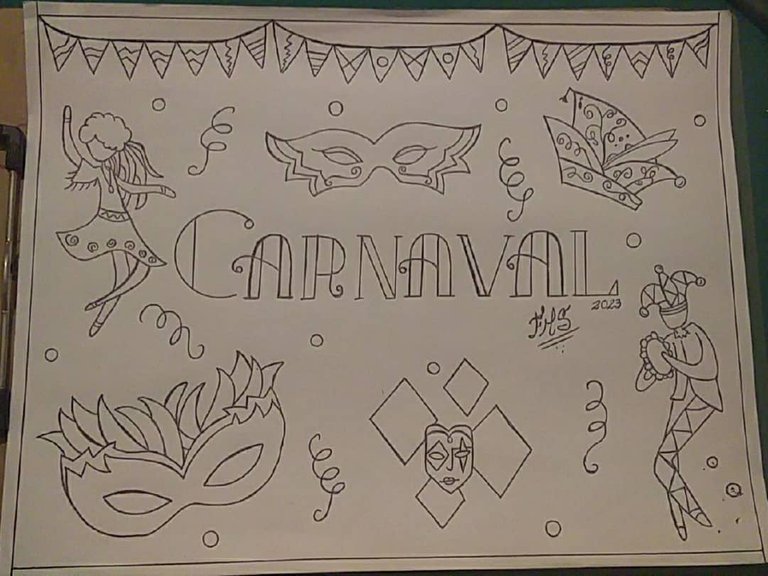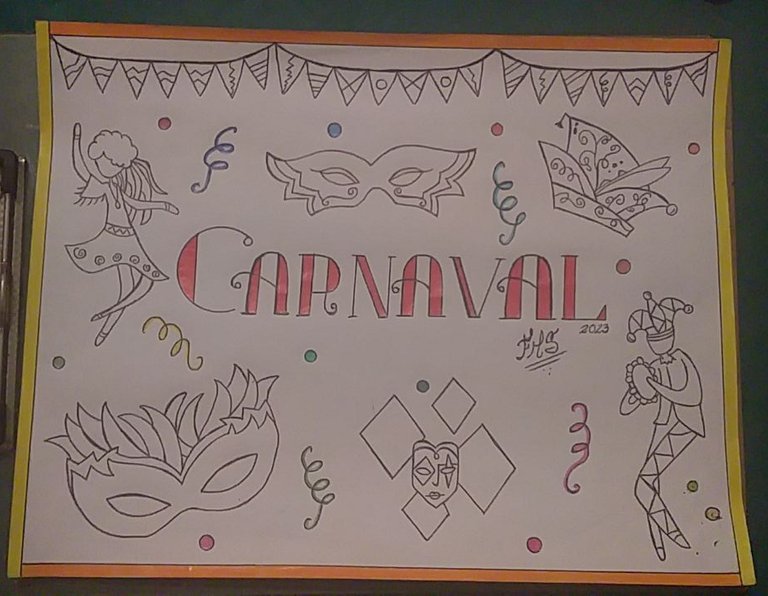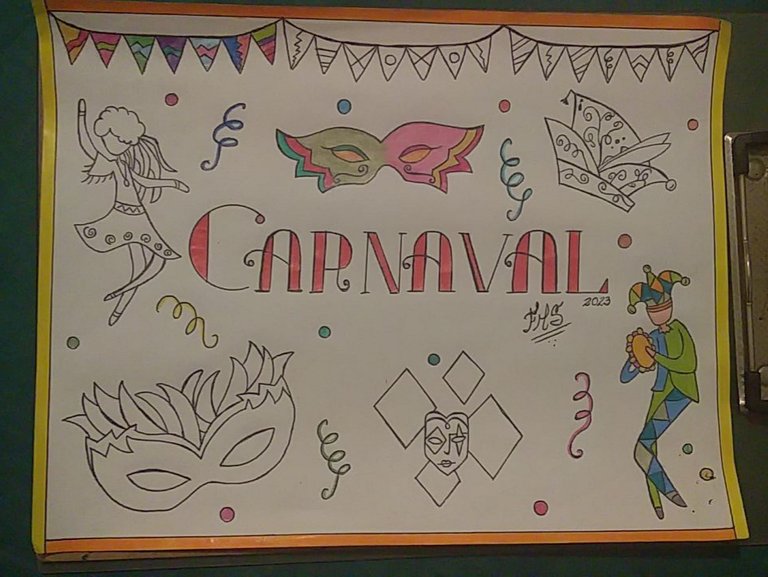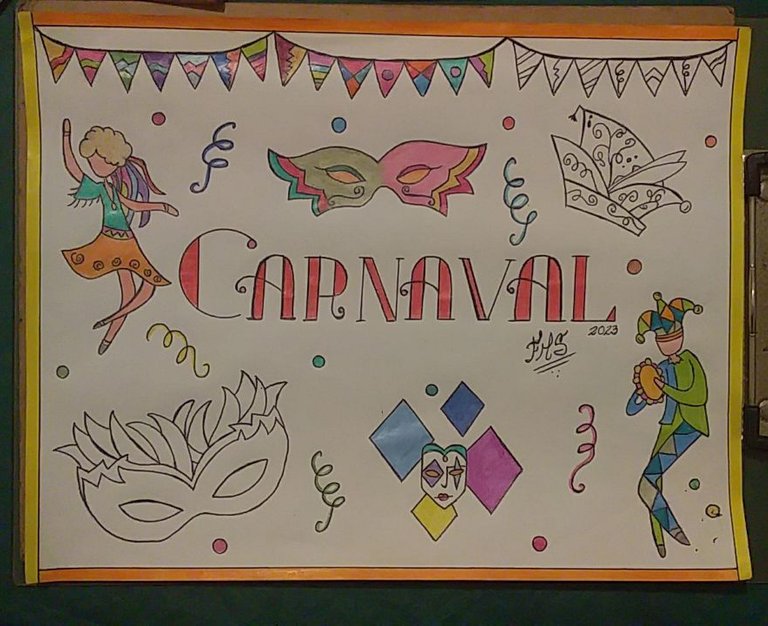
Título: "Carnavales: más que algarabía, disfraces y celebraciones." Por Florencia Renata.
El carnaval es una festividad celebrada en muchos países católicos durante los días que anteceden a la cuaresma. Estas fiestas se caracterizan por presentar bailes, disfraces, desfiles, música, mascaradas y diferentes manifestaciones de júbilo y algarabía popular.

Dibujo realizado por el autor.
El origen de la palabra carnaval es incierto, sin embargo existen algunos indicios de que se relaciona con los términos carnem levare o carnelevarium del latín medieval que referencia a "quitar o remover la carne", asociándose con el período que los católicos están por iniciar donde el consumo de carnes es restringido. Otras fuentes, por su parte, aseguran que proviene de carrus navalis gracias a las embarcaciones que eran colocadas sobre cuatro ruedas, para que recorrieran las calles de la Roma pagana como parte de cultos a la fertilidad.

Dibujo realizado por el autor.
También se hace difícil determinar el origen históricos de estas celebraciones, sin embargo, es imposible no asociarlo con algunos rituales de la antigüedad. Como por ejemplo: los egipcios hacían desfiles y fiestas para rendir culto a la diosa de fertilidad, Isis; del mismo modo los griegos le celebraban con cantantes, bailarines y enmascarados a su dios de la fertilidad, Dionisio, para dar inicio a la primavera; los antiguos romanos en sus fiestas al dios Saturno invertían el orden de su estructura social, para celebrar sin limites ni restricciones. En los primeros años de nuestra era, hombres y mujeres intercambiaban ropas, usaban máscaras y realizaban bailes y grandes fiestas, en honor al dios del vino y a la diosa del amor, Baco y Venus. Costumbres romanas que se extendieron por países como Francia, España y Portugal.

Dibujo realizado por el autor.
En la edad media se destacó el carnaval de Roma ya que contaba con el beneplácito del Papa. En los siglos XV y XVI. De la ciudad de Florencia proceden las canti carnascialeschi (canciones carnavalescas). Los bailes de disfraces fueron las manifestaciones de carnaval que se arraigaron de manera especial en Francia e Italia en esos siglos y en los siguientes. El desarrollo del teatro popular fue una muestra inequívoca de la influencia de estas fiestas en las expresiones artísticas.

Dibujo realizado por el autor.
En la actualidad, los carnavales están despojados del carácter pagano primitivo y transgresor de sus inicios, aunque mantiene su sello de fiesta colectiva y pública. Se continua celebrando en Europa, principalmente en los países meridionales; en los Estados Unidos se destaca el Mardi Grass que se celebra en Nueva Orleans; y en los países de América Latina sobresale el de la ciudad de Río de Janeiro en Brasil. Tradicionalmente, el carnaval culmina el martes anterior al miércoles de cenizas. Hoy en día, se celebra solo durante los tres días consecutivos previos a la cuaresma (domingo, lunes y martes).

Drawing made by the author.
English: Title: "Carnivals: more than the hubbub, costumes and celebrations."By Florencia Renata.
Thecarnival is a festivity celebrated in many Catholic countries during the days preceding Lent. These festivities are characterized by presenting dances, costumes, parades, music, masquerades and different manifestations of jubilation and popular hubbub.

Drawing made by the author.
The origin of the word carnival is uncertain, however there are some indications that it is related to the terms carnem levare or carnelevarium from medieval Latin that refers to "to remove or remove the meat", associating with the period that Catholics are about to start where the consumption of meat is restricted. Other sources, on the other hand, assure that it comes from carrus navalis thanks to the boats that were placed on four wheels, so that they traveled the streets of pagan Rome as part of fertility cults.

Drawing made by the author.
It also becomes difficult to determine the historical origin of these celebrations, however, it is impossible not to associate it with some rituals of antiquity. For example: the Egyptians held parades and parties to worship the goddess of fertility, Isis; in the same way the Greeks celebrated with singers, dancers and masked their god of fertility, Dionysus, to start spring; the ancient Romans in their parties to the god Saturn reversed the order of their social structure, to celebrate without limits or restrictions. In the early years of our era, men and women exchanged clothes, wore masks and held dances and large parties, in honor of the god of wine and the goddess of love, Bacchus and Venus. Roman customs that spread to countries such as France, Spain and Portugal.

Drawing made by the author.
In the Middle Ages, the carnival of Rome was highlighted because it had the approval of the Pope. In the fifteenth and sixteenth centuries. From the city of Florence come the canti carnascialeschi (carnival songs). The masquerade balls were the carnival manifestations that took root in a special way in France and Italy in those centuries and in the following ones. The development of the popular theater was an unequivocal example of the influence of these festivals on artistic expressions.

Drawing made by the author.
At present, carnivals are stripped of the primitive and transgressive pagan character of their beginnings, although they maintain their stamp of collective and public celebration. It continues to be celebrated in Europe, mainly in the southern countries; in the United States, the Mardi Grass held in New Orleans stands out; and in Latin American countries, the one in the city of Rio de Janeiro in Brazil stands out. Traditionally, the carnival culminates on the Tuesday before Ash Wednesday. Nowadays, it is celebrated only during the three consecutive days leading up to Lent (Sunday, Monday and Tuesday).